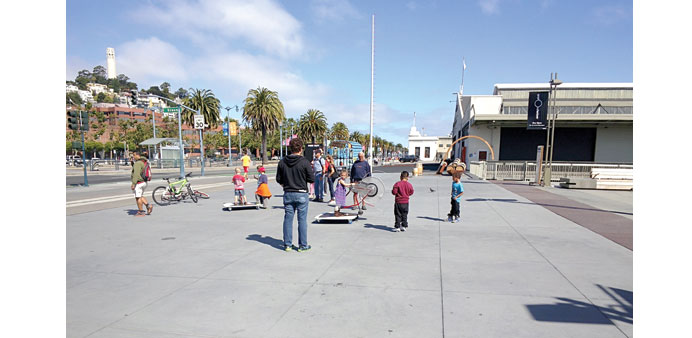By Catharine Hamm
After you slip on Google Glass — the new computer you wear on your face — you get things rolling with the voice command, “OK, Glass.” Then you tell the eyeglass-like contraption what you want it to do — take a picture, shoot a video, give you directions, tweet and more.
When I experimented recently with Google Glass in the City by the Bay, my second command was this: “OK, Glass. Help me see San Francisco through new eyes.”
SF and I have a sometimes-less-than-OK relationship, mostly my fault (thanks to traffic tickets, romantic weekends that weren’t, body parts that malfunction), not the city’s (except for that epic rainstorm two years ago, not that I’m bitter).
But it’s also a familiar place that offered a basis of comparison to help me see how well this titanium-framed little tech wonder would work and whether it could change a traveller’s perspective. Nob Hill’s Stanford Court hotel was offering a Google Glass package that allowed a tryout without laying out $1,500 for something I wasn’t sure about.
My experience with Glass? Just OK.
I’m neither a techie nor a quick study. I use PCs and an iPhone (Glass is an Android device), and I think I know more about technology than I do, so I am grateful for electronics that don’t require a PhD to operate.
Glass didn’t require a doctorate, but it did take a bit of explanation, which is why I visited Google Base Camp in Los Angeles for a demo beforehand. There I learned that I needed some extra gear and other apps to get the most use out of Glass.
Even with that grounding, it wasn’t always easy to make Glass bend to my will, despite the voice command and the tap-and-swipe-the-temple-touchpad feature (the mouse, as it were). I sometimes found myself swiping when I should have been tapping and vice versa. More user time might have solved that problem. The little screen above my right eye wasn’t always easy to read, partly because I wore Glass over my glasses.
With experience, I might become a convert, even though I don’t think Glass, which was offered for sale online starting in April, is ready for prime time. Still, by the end of my Bay Area stay, I was swiping and tapping, photographing and videoing like a semi-advanced amateur.
Thanks to my quest, I had a chance to enjoy again the Exploratorium museum, Lands End and the Conservatory of Flowers on a beautiful summer day. A nighttime bus tour that wound through the city let me see the Bay Bridge from Treasure Island just as the sun was dancing off to bed.
I captured some of it on Glass, some with a point-and-shoot camera and some with a single-lens-reflex camera. Which was best? You can judge the results.
Perhaps the best travel use of Glass occurred on Sunday morning as I walked down California Street to Old St. Mary’s Cathedral. The Field Trip app offered quick lessons in history and architecture along the way. Inside the church, I violated etiquette by using Glass to photograph and take video of the interior, but I will treasure those visual mementos as reminders of an uplifting Sunday message.
In the end, the message of my Glass experience was better than the experience itself: Try something new. Change your perspective. Don’t be afraid to fail. It’s rarely fatal.
More than OK, Glass. — Los Angeles Times/MCT
GOOGLE GLASS CAMERA VS. NIKON SLR AND NIKON POINT-AND-SHOOT
To see how well the Google Glass camera stacks up, I took it, a Nikon SLR and a Nikon point-and-shoot to several places in San Francisco. My disclaimer: I am not a trained photographer, and if I took an IQ test of visual intelligence, I’d rank in the bottom of the class.
So I asked Kathy Pyon, one of the Los Angeles Times’ photo editors, to evaluate the results. Here is her report card:
Bay Bridge at sunset
Winner: Nikon SLR
Compositionally, the Nikon picture looks better because of the framing of the photo, although the way Glass captures the blues is impressive.
Conservatory of Flowers
Winner: Glass
Both look good, but the deeply saturated colours of the point-and-shoot look almost unnatural. The colour range from Glass is nice and realistic in daylight.
Exploratorium, Pier 15
Winner: Glass
The colours that Glass captures are rich and natural. The downside: To compose this photograph without less means getting closer. An interchangeable lens would help Glass.
Stanford Court hotel room
Winner: Nikon
The Nikon has the advantage of having a flash. The composition and lighting are cleaner.
Lands End
Winner: Both
These are hard to compare, but Nikon has the edge. The zoom lens helped capture the moment. The sky and rocks in Glass look great; it picked up the texture nicely.



